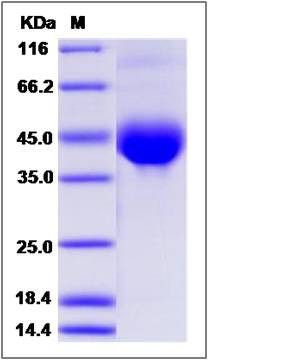Canine NRG1-alpha Protein (ECD, His Tag)
NRG1
- 100ug (NPP1673) Please inquiry
| Catalog Number | P70084-D08H |
|---|---|
| Organism Species | Canine |
| Host | Human Cells |
| Synonyms | NRG1 |
| Molecular Weight | The recombinant canine NRG1 comprises 233 amino acids and has a predicted molecular mass of 25.5 kDa. The apparent molecular mass of the protein is approximately 39-46 kDa in SDS-PAGE under reducing conditions due to glycosylation. |
| predicted N | Ser 19 |
| SDS-PAGE |  |
| Purity | > 90 % as determined by SDS-PAGE |
| Protein Construction | A DNA sequence encoding the canine NRG1 isoform alpha (XP_858147.1) extracellular domain (Ser19-Lys240) was expressed with a C-terminal polyhistidine tag. |
| Bio-activity | Measured in a serum-free cell proliferation assay using MCF‑7 human breast cancer cells. The ED50 for this effect is typically 0.2-2 µg/mL. |
| Research Area | Immunology |Signal Transduction |Nuclear signaling |Nuclear Hormone Receptor |Co-activator & Co-repressor |
| Formulation | Lyophilized from sterile PBS, pH 7.4. 1. Normally 5 % - 8 % trehalose and mannitol are added as protectants before lyophilization. Specific concentrations are included in the hardcopy of COA. |
| Background | Neuregulin 1 or NRG1 is one of four proteins in the neuregulin family that act on the EGFR family of receptors. This growth factor was originally identified as a 44-kD glycoprotein that interacts with the NEU / ERBB2 receptor tyrosine kinase to increase its phosphorylation on tyrosine residues. NRG1 is a trophic factor that has been implicated in neural development, neurotransmission, and synaptic plasticity. NRG1 has multiple isoforms that are generated by usage of different promoters and alternative splicing of a single gene. Neuregulin 1 (NRG1) is essential for the development and function of multiple organ systems, and its dysregulation has been linked to diseases such as cancer and schizophrenia. NRG1 is a schizophrenia candidate gene and plays an important role in brain development and neural function. Schizophrenia is a complex disorder, with etiology likely due to epistasis. |
| Reference |
